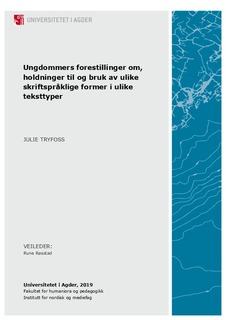| dc.description.abstract | This thesis examines how youthsrelate tothe use of distinctiveforms of written language in different text types, and the following research question has been chosen: How do youthsrelate todistinctiveforms of written language in different text types?In assessing this research question the youths’attitudes and perceptions related to the use of the different written language forms in formal andinformal text typeshave been studied, in addition to discussing whether these perceptions and attitudes can say something abouttheiruse ofvarious written forms in distinctive situations. The five forms of written language that are examined are both withinand outside of the official orthography: dialect-specific wordsforms, incorrect grammatical forms, English words and expressions, emojis and radical and moderate forms in the bokmål orthography. The written standard bokmålis the starting point for the research. The research in this thesis is based on a survey fromtwo high school classes and was carried out in the fall of 2018. The survey consisted of a set of claims for the youths to consider, questions to answer and then aseparatepart where theycould elaborate on their answers. A considerable part of the findings conforms with traditional perceptions and pre-existing research on the area, although the study also has given new and more nuanced insight into how youthsrelate tothe written language.The youthsin the study seem to value correct language, meaning writtenforms within theofficial orthography, especially in formal text types. This tendency is evident in that they are negative to the use of the written wordforms outside theofficial orthography. However, the youthsalso expressed that correct language holds greater importance in formal text types than in informal text types, due to thehigher tolerance for incorrect forms in informal settings. The results from the research can, therefore, support the hypothesis that youthshave a certain acknowledgment of language genres, shown in theirclear perceptions of the appropriate use of language in the different text types. While the youthsseem to value correct language, there are still cases where they are positiveto incorrect formsand negative to correct forms. The youthsare especially negative to the use of the low-frequency "norwegianized" English forms, as well as the low-frequencyradical forms in the bokmålorthography.Some of the answers from the survey are therefore inconsistent. Thus, this thesis argues that theyouths’ negative attitudes to correctforms may be the result of a scarcity of knowledge to the norm, which is tied to the frequencyof the wordsin the written language. | nb_NO |

